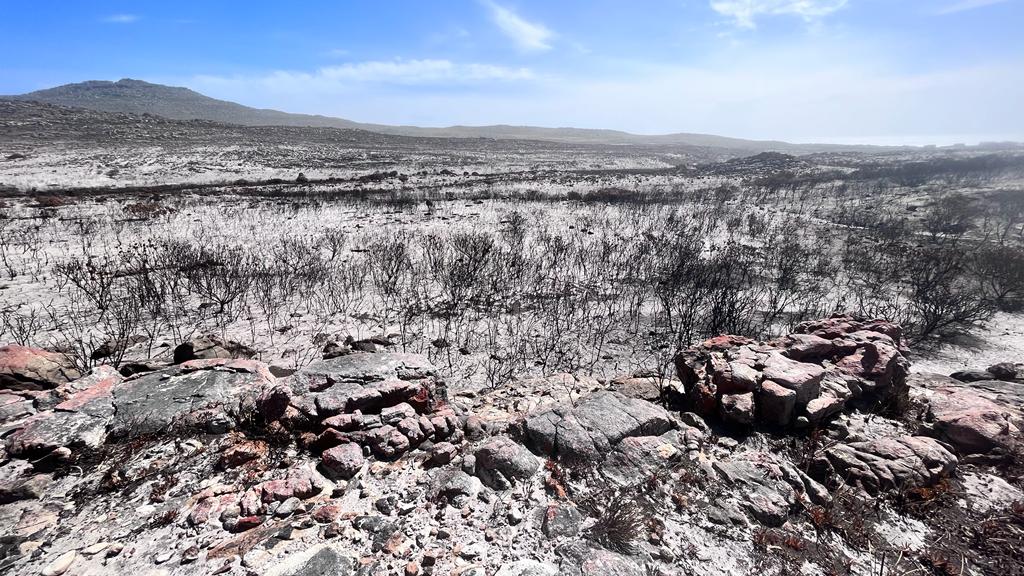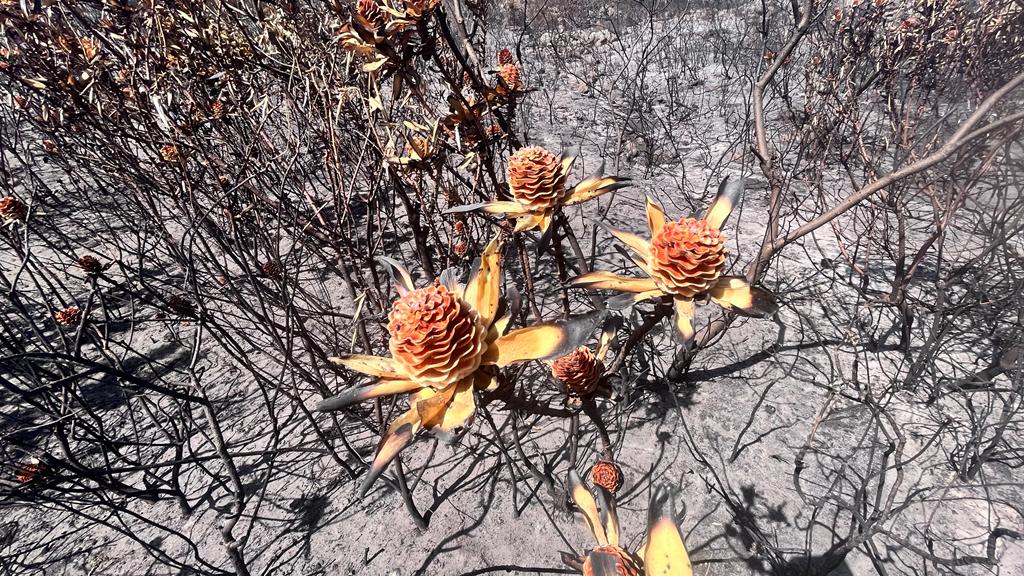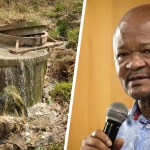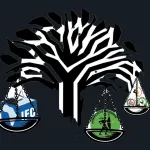Except for a 30m cordon of unburnt fynbos, the vegetation on the mountain slopes on all sides of my house has been reduced to ash and dust by the devastating fire that swept through the South Peninsula last week.
For eight days and nights, the howling winds pushed the flames towards us, devouring thick stands of fynbos and invasive alien plants, only to be pushed back by firefighters, ground crews and helicopter pilots. These indomitable men and women came and went as their command control pulled them up and down the peninsula to battle the fire on multiple fronts.
As I walked through carpets of ash, slipping and falling whenever the ground gave way beneath my feet, I was reminded by the apocalyptic view (which in many ways was a tangible manifestation of climate collapse) that, for those who are not sleepwalking, a doomsday perspective increasingly defines our response to the crumbling world order in which we live and which we will bequeath to the next generation.

A view of the burnt-out vegetation in the Cape Point Nature Reserve on 26 December 2023. (Photo: Stephen Lamb)

The aftermath of the fire, Cape Point Nature Reserve on 26 December 2023. (Photo: Stephen Lamb)
This mountain may recover when the winter rains arrive, even in an El Niño year. But there is less cause for optimism about the Amazon, where rainforests the size of the area that burned south of Simon’s Town (33,000 hectares) are felled every 90 minutes.
From my vantage point on this burnt mountain, I looked down on False Bay where fish stocks have collapsed — as they have all over the globe — and which is now home to a mere 1.5% of the fish that it harboured in precolonial times.
The mammals, birds and insects that thrived on the Cape Peninsula have been reduced to a fraction of what they once were. How do we not see, or why do we deny that we are sliding towards massive changes in how we will have to organise our society and change the way we relate to the planet, which we currently use as a limitless resource and a garbage tip? We need to make these changes, not to prevent collapse, but to be better prepared for it.
If there is one thing that our hyperconnected world has taught us, it is that all opinions, even perspectives, are complex and multifaceted. When looking down the mountain towards the road that winds its way to Cape Point, I did not only see a moonscape of ash and dust. I saw the triumph of eight days and nights of heroic human endeavour.
Not a single one of the 30-odd houses in my small neighbourhood had burnt down. The few that were surrounded now by charred vegetation, right up to their doorsteps, were testimony to the human-created miracle that had played itself out during the week of relentless battles with hellish fires riding on the wings of ferocious winds.
Collective mettle
The first line of defence was constituted by the residents themselves. They are a mix of pensioners, whose modest cottages have been passed down through the generations, and a more recent set of affluent families bringing gentrification in their wake — although not with the same level of racial and class dislocation as larger and more diverse neighbourhoods such as Woodstock, Bo-Kaap and Kalk Bay.
From a strictly sociological point of view, it would be a stretch to call them a community, although they do maintain a vibrant neighbourhood WhatsApp group which concerns itself primarily with perceived and real security threats and with the movements of the resident baboon troop. As a general rule, matters of purpose are individualised around self-interest, while any sense of collectivity is based more on bonhomie and shared grievances. In other words, a typical suburban neighbourhood.
This all changed profoundly on 19 December when the fires began. The loosely bonded community proved its collective mettle. In the face of a very real common threat, individual risks lined up perfectly with the need for solidarity and collective action. This is not unusual.
Even in well-organised communities with robust civic structures, the common good comes to the fore (not always) when individual and communal risks coincide. When there is no significant, imminent threat, community members tend to see the goings-on of their neighbourhoods in a rather detached way — from above.
When the shit hits the fan, the community members know that community is something they are enmeshed in. Community comes alive and quickly becomes greater than the sum of its parts.
The WhatsApp group sprang to life, alerting neighbours to encroaching flames, chasing down firefighting officials and tapping into contacts in the fire control centre.
This was followed by hands-on support — dousing flames when fire crews were not available (by day two they were spread thin, fighting the fire for kilometres to the north and the west), doing hourly sorties by car from Cape Point to Murdock Valley, and most interestingly, opening channels of communication and information-sharing with neighbourhoods to the north and the west that were facing the same threats.
The second line of defence was the fire engines and their firefighters, soon stationed all along the road to Cape Point, laying out their hoses at critical spots, sometimes almost 100m up the mountain.
Where the flames were too high up or simply inaccessible they waited calmly on the roadside together with anxious homeowners while helicopters were pulled from other neighbourhoods under threat to come and dump 1,000 litres of seawater at a time on the engulfing fires.
When the helicopters flew off, the ground crews moved in. Armed with beaters, shovels and spades they clambered over rocks, slipped down slopes covered in powdery ash and astonishingly found ways to make it to the smouldering hotspots and extinguish them.
By the time the City of Cape Town authorities announced that the fire had been contained, one week after its commencement, homeowners and firefighters were equally exhausted.
The firefighters probably did not share the elation and relief felt by the homeowners. After all, this is their job or vocation, which means they have had extensive exposure to the drama and fear that accompany ferocious fires. This would explain, together with extensive training, their effectiveness and skill, and the empathetic and approachable way in which most of them engage the public.
A microcosm of the climate crisis
And so it was that from my vantage point on the burnt slopes of the mountain I scanned a scene in which extraordinary paradoxes had played themselves out.
In the process, I witnessed a microcosmic, almost simulated articulation of the climate crisis and detected ways in which humanity might respond, as cogently articulated by the Dark Mountain Project. Not with the wishful thinking of preventing a looming environmental and social collapse, but with the practical and level-headed understanding that if we don’t reimagine the way we organise ourselves, the human predicament is going to get far worse, and much more quickly.
This reorganisation must begin at the local level, in the neighbourhood, on the ground. It must be driven by communities and it must be an orchestrated collective response to tangible subjective threats.
Another lesson from my small neighbourhood’s response to the devastating fire is that while localisation certainly means greater dependence on local people and local resources, it dare not result in isolation.
Superaffluent individuals and neighbourhoods may seek — and partially succeed — to hole up behind heavily guarded walls or even to try to relocate to Mars. For the rest of us, this is not an option.
Not only do we need to find ways to incentivise collective action in our neighbourhoods, we need to build connections to other organised neighbourhoods. Local structures will need to create ever-expanding networks, bringing together other locally based structures that are ready and able to play active and proactive roles in equipping themselves to face what lies ahead for all of us.
A key but highly unreliable actor in this scenario is the state. The different fire departments in the City of Cape Town were exemplars, this past week, of effective local-government intervention.
Two-pronged approach
Sadly, they are also the exceptions to the norm. Given the fact that most government institutions across the globe fail to act in the interests of the majority of citizens, it is necessary to develop a two-pronged approach.
At the same time that allies in government must be continuously sought out and supported (governments are not monolithic), organised communities dare not depend on governments to make decisions in their interest or put them into practice. Communities need to set and protect their agendas.
If they continue to look to elements of the dying order to solve their problems, whether it be politicians, academics or technologists, it may well be the beginning of the end of social organisation and our extractive economy as we know it — the end of the Holocene — and the acceleration of ecocide and social collapse.
The experience of fighting a fire in a small peri-urban hamlet serves as graphic testimony to the arguments of many climate activists, not least “Just Collapse” an association of urban planners whose documentation has long asserted that local-level organising and networking across suburbs, cities and districts are the clearest ways in which to prevent the end of life on Earth. DM

















“As I walked through carpets of ash, slipping and falling whenever the ground gave way beneath my feet, I was reminded by the apocalyptic view (which in many ways was a tangible manifestation of climate collapse) that, for those who are not sleepwalking, a doomsday perspective increasingly defines our response to the crumbling world order in which we live and which we will bequeath to the next generation.”
Eish! Prepare to meet thy doom!
Doomsday sayers are sooo old hat. So outdated flavour of the week. So BORING! Enough to drive one to drink.
The Doomsdayers err on the side of apocalyptic predictions; the reality is a slow slide into barrenness and filth. Uncontrolled areas like the ocean are stark in its demise – ask any recreational fisherman or diver. On land things are not so apparent, unless you can compare it to old photos – the loss of forests, glaciers and wilderness in general. Plastic pollution is everywhere and anywhere. Streams of sewage pouring into our rivers and seas. I can go on. You need not be a scientist to know we’re turning the planet into a garbage heap.
The article is really about the response of a local community to the crisis and it gains it’s rhetrocial strength from the tension between large centralised government responses to an ecological threat and these more local networks. If you’re interested in a proper academic view there’s a slim volume by Ophuls “with apologies to the grandchildren”. Here’s the blurb. Why are we sleepwalking toward a foreordained ecological collapse? What is the connection between the ecological crisis and the breakdown of liberal democracy? What do political history and philosophy, along with anthropology and depth psychology, have to say about these issues? And what will society look like when we exhaust solar capital in the form of fossil fuels and must live once again on the daily and seasonal flow of solar income? These interlocking essays throw light on all these questions, illuminating the forces that will determine the long-term future of humanity.
Fynbos of course canonly propagate by fire. I read elsewhere that some of the affected areas had not burned for forty years… too frequent is also undesirable, 15 years being optimal apparantly.
yup 15 to 25 years otherwise it becomes moribund. it does propagate without fire, but fire sets off massive germination of seeds. unfortunately also of the invasive species (notably Australian ones). In Table Mountain National Park you have areas that burn every 2 or 3 years at the moment, turning into grassland, and then areas that haven’t burned for 40 years.
Ideally it should burn every 7 to 10 years
That’s simply not true. Fynbos did not evolve under a regime of regular planned fires. The reality is far more complex
A great article thank you. It makes me think about urban planning in the future. I also live in a fynbos area and we lost our home to fire in 2017. Knowing that fires will come again, we rebuilt our home. It seems illogical. Yet so many people build our homes in fynbos with threat of fire, on dunes with threat of rising waters, in flood plains, on seismic faults or below volcanoes….
Great article indeed. We also live in the Deep South of Cape Town. Luckily not on the urban edge and so hopefully safe from fires. We are at least a few meters above sea level so we may end up being beach front but should be OK. We live right on top of the fault that twisted Cape Point off the Muizenberg mountain. I always keep a pump ready to drop into swimming pools for whichever friend on the mountain slope is under treat this time. Something everyone living in a fire risk area should do.